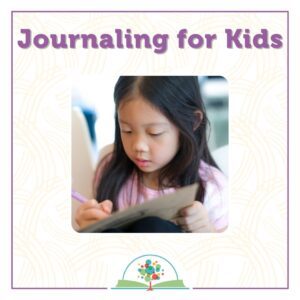11 Apr Journaling for Kids
 Developing a journal routine has many outstanding benefits for children of all ages including improved writing skills, reading comprehension, creativity, and emotional intelligence. However, in order to maintain a journaling practice for children, it is important to make the experience fun and enjoyable. Listed below are several types of journals to try so you and your child can find what works best.
Developing a journal routine has many outstanding benefits for children of all ages including improved writing skills, reading comprehension, creativity, and emotional intelligence. However, in order to maintain a journaling practice for children, it is important to make the experience fun and enjoyable. Listed below are several types of journals to try so you and your child can find what works best.
Types of Journals
About Me Journal
An “About Me” journal can help children begin their journaling habit by focusing on something they know a lot about – themselves! This format can help get the writing practice established while allowing your child to think about themselves in different ways. It also provides a great opportunity for self reflection and identifying areas of growth.
Some example prompts include: “What is my favorite holiday and why?” or “If I had a perfect day, what would I have for breakfast, lunch, and dinner?”
Gratitude Journal
A gratitude journal can help children identify and appreciate the positive aspects of their day-to-day lives. Whether this focuses on the little things or big victories, practicing gratitude can help children regulate emotions and cope with challenges.
Example prompts could include: “What was my favorite part of today?” or “Name 3 activities that bring me joy.”
Nature / Travel Journals
Nature and/or travel journals are great for adventurous and curious minds. These journals can be used to help children develop vocabulary by interacting with the world around them. Travel journals can be useful for recording fun memories when traveling with family during school breaks.
Example prompts for nature/travel journals: “What kind of plants do you see in the spring? What about the summer?” or “What are some differences between where you live and the place you visited over spring break?”
Question-A-Day Journal
These types of journals allow for a range of topics and prompts, allowing children to broaden their creativity and really develop their writing skills. By asking a single question each day, the journaling process remains new and exciting.
Example prompts include: “If you were to be the main character of a book, what genre would you choose?” or “If you could be an expert in one subject in school, what would it be and why?”
Bullet Journal
Bullet journals allow children to create their own format of journaling including drawings, charts, mood-check ins, book/movie reviews, and more. T journals can help organize multiple interests a child may have while giving them the space to engage artistically with their journaling practice.
Digital Notebooks
For those who may be less interested in traditional journaling, digital notebooks may be a great option to maintain a child’s journaling routine. Several applications on personal devices and tablets provide several types of journals so that you and your child can find the perfect fit. Before downloading a notebook app for your child, be sure to check the user agreements and safety settings.
Whether you or your child has journaled before or not, these recommended journal formats are only a few options available to make your journaling practice work for you. Use one or a combination of your favorites to find the perfect fit. Just remember to keep the experience positive and enjoyable.
Read more
- You Can Write an Amazing Journal
- Globejotting: How to Write Extraordinary Travel Journals
- Writer’s Toolbox: Learn How to Write
- How To Write A Journal
Explore writing prompts and additional strategies for children’s journaling (source): https://www.adventurebook.com/connect/journal-prompts-for-kids/



